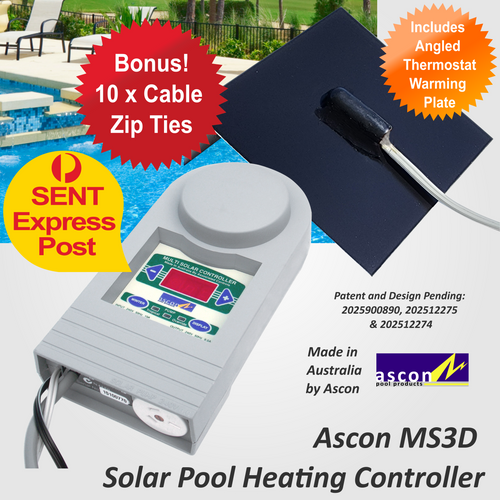Solar Controllers
Swimming Pool Solar Controller Guide
Article was written by Gregory Grochola (physicist) - 11/09/2025
This guide on solar pool heating controllers will help you decide on the type of solar pool heating system and hence controller you want to set up for your needs.
Table of ContentsClick Heading Titles to Navigate Up or Down

Some controllers can also have a special mode for peak summer, which will cool a pool if it gets too hot (mainly used for northern Australian areas). Other functions of full-featured controllers include freezing protection to prevent collectors from freezing over in frost-prone areas, as some collectors are susceptible to damage from having water freeze inside them if there is no way to fully drain the system. Lastly, there is winter mode, where a solar controller will pass some water through a solar system to flush any stagnant water during winter.
When choosing a solar pool heating controller you may have few options depending on whether or not you have independent solar inlet/outlet lines going into your pool, or could easily put those in. We always recommend an independent type system for both system thermal and electrical efficiency, given it's the most versatile way of running a pool heating system.
These two system types are essentially the same and use the same controller. The term "independent" refers to the dedicated solar inlet/outlet ports that are pre-installed in the pool by the pool builder; dedicated to the solar system - hence the solar system can run independent of the filter system. An "integrated" system is simply an "independent" system where the solar suction and return lines need to be retrofitted to an existing pool that has never had "independent" inlet/outlet solar ports installed.
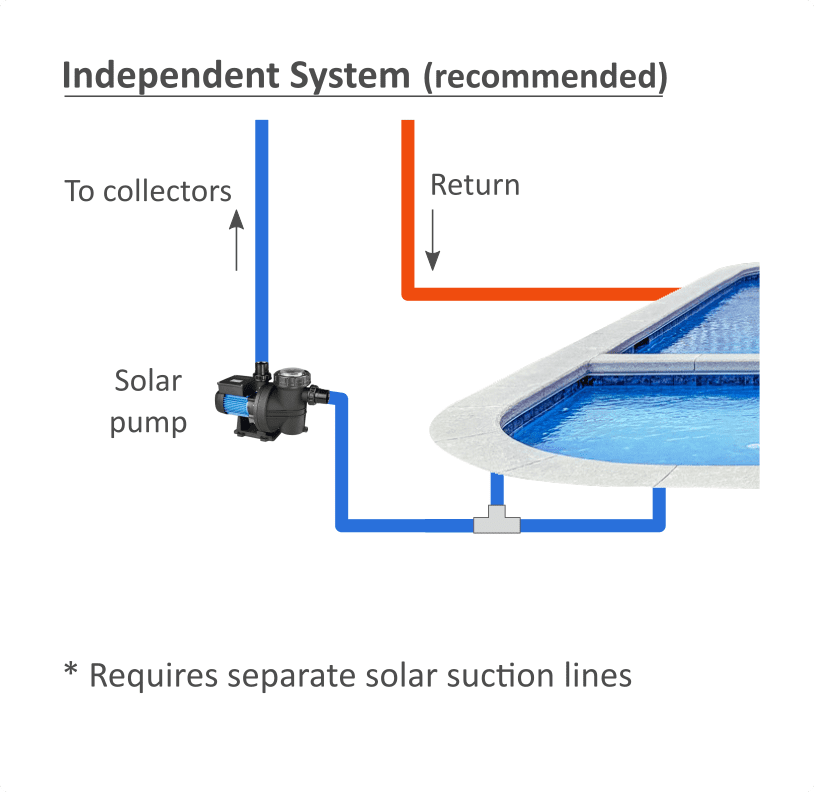
2.1.1 Independent System
Independent pool heating systems run a small dedicated solar pump, typically for 8 hours per day; they are the most common type of system in Australia. They are versatile, as they can run independently from the main filter system, and are actually more energy efficient than systems running through the main filter pump, which are forced to run the large filter pump for 8 hours per day just to pump the solar side.
Independent systems require separate solar suction and return lines; for older pools these might not have been installed.
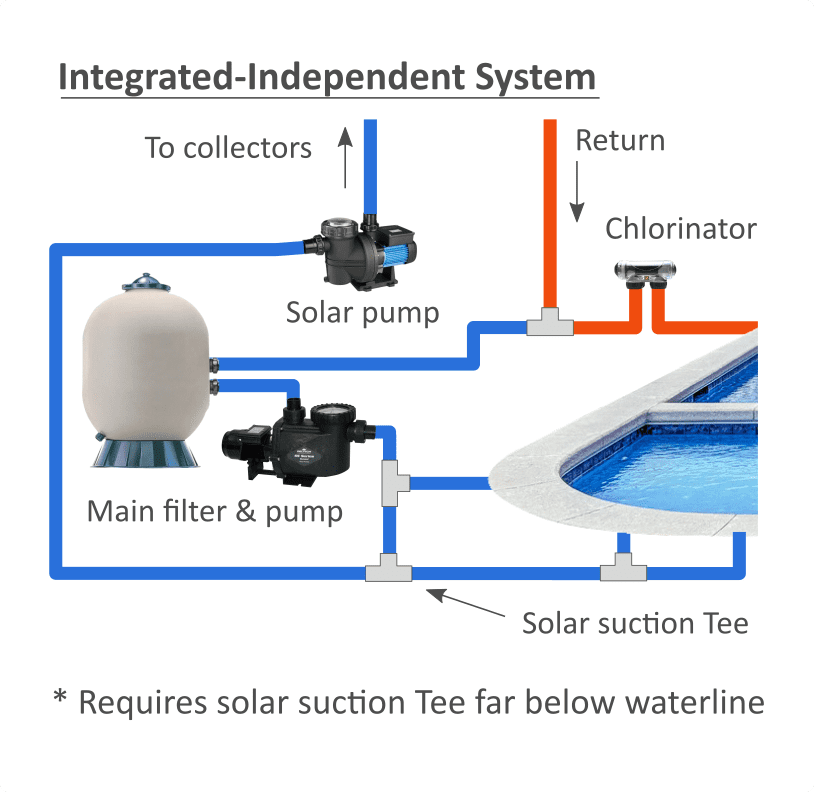
2.1.2 Integrated System
Integrated pool heating systems are almost identical to independent systems, but are actual retrofits where dedicated solar suction lines are retrofitted into the pool. This is not always easy as solar suction lines are best tapped or tee'd-in into existing suction lines well below water level; otherwise the solar side tends to cause de-priming issues with the main filter pump. There are also regulations that mandate suction lines must consist of two inlet ports connected via a tee and separated by a minimum distance in case of swimmer entrapment.
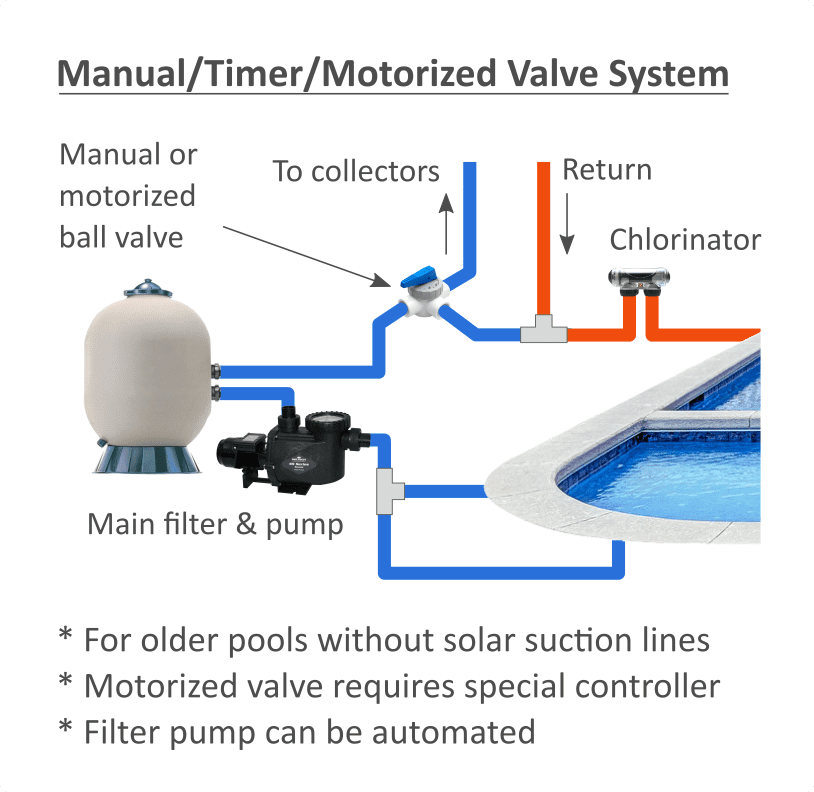
Motorized auto-valve systems are systems that tee the solar in after the main filter using a 3-way ball valve; typically this system type is chosen due to lack of solar ports. The solar system is dependent on the main filter to pump water through collectors; as such, systems are slightly less electrically efficient than an independent/integrated system, since typically pools only require a single turnover of water per day depending on pool usage, while solar can mandate running the main filter pump for 8 hours.
When teeing in the solar, one has the option of using a manual 3-way ball valve and a timer to run the main filter pump during sun hours as a type of semi-manual system to start with, with an option to upgrade to a motorized ball valve with controller later. If you're planning this, however, make sure to install the correct 3-way ball valve so that the changeover is easy, as not all 3-way ball valves can be retrofitted to a motorized version.
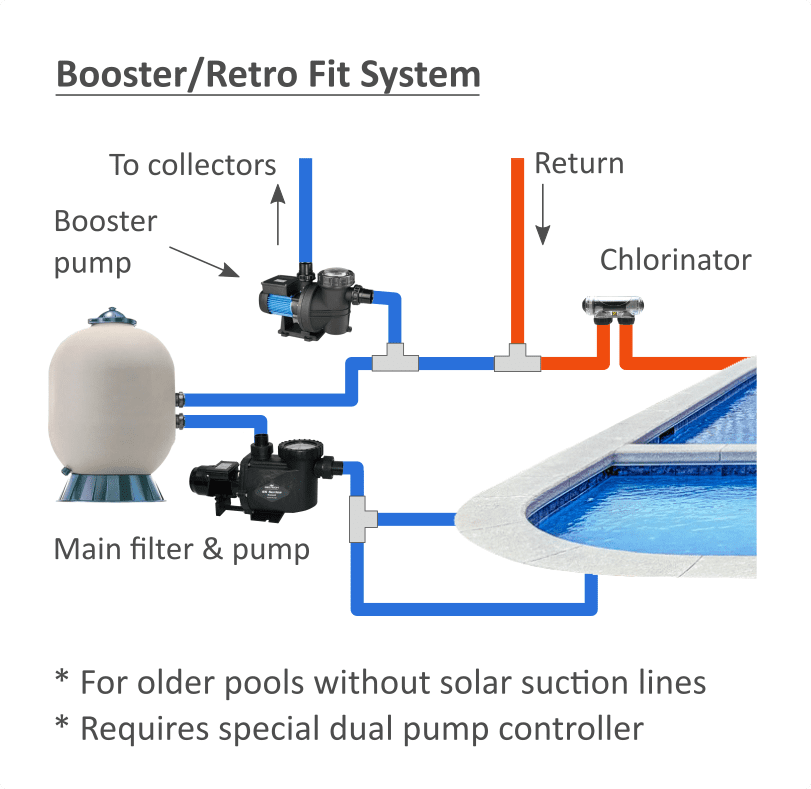
Booster pump systems are systems that tap the solar in after the main filter, typically done due to lack of solar ports. The solar system is dependent on the parallel running of the main filter pump in conjunction with a small booster pump. Such systems are slightly less electrically efficient than an independent/integrated system, since typically pools only require a single turnover of water per day depending on usage, while solar can mandate the running of two pumps for 8 hours.
Booster systems are somewhat suited for two-storey roofs or higher as a booster pump naturally helps to pump water to such heights. Booster systems are also best suited for pools that use a low-flow or variable-speed pump, as these pumps tend to have a high surge current at start-up, which puts stress on polymer collectors that are momentarily hot at start-up. A booster controller will start the system and wait until the filter settles to a lower current before starting the booster pump so as not to over-pressurize the solar collectors.
Independent controllers connect and control a single dedicated solar pump that's turned ON depending on the pool's heating requirements and available solar energy. They have two temperature thermostats; a pool sensor (connected to the solar suction line) and a roof sensor (installed on the roof, typically near the collectors). Sampling of the pool's temperature is performed by turning on the solar pump and allowing pool water to flow over the pool sensor; the controller takes a reading after some time. If the pool temperature is greater than the roof temperature (by typically 8-9ºC) then the unit remains ON; if not the unit shuts OFF and waits 15 mins before sampling again. Sampling in the morning starts when the roof temperature is detected to be warmer than the last pool temperature reading performed the day before.
Different controllers have different features that may be important to you; below is a table.
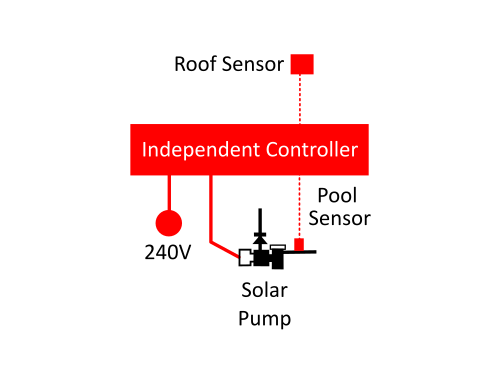
* Tropical Mode will not function on this unit in Queensland Tariff 33, as it does not have clock and battery backup to retain settings after outage.
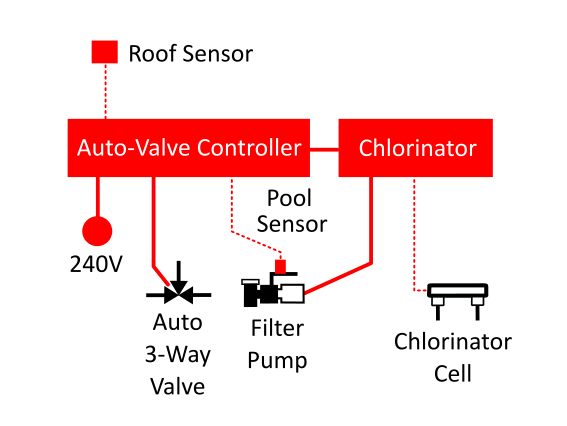
An auto-valve solar controller essentially works on the same principle as an independent controller; namely, it monitors the pool temperature and roof temperature and, if required, sends water to the collectors to warm the pool. The main difference is twofold: firstly, it uses the main filter pump to send water up to the roof by diverting the water to the roof using a motorized ball valve. The second main difference is the controller is also responsible for ensuring a minimum level of filtration of the pool's water by running the filter pump without pumping water up to the roof if, one, the pool is up to temperature, and two, there is no solar to be gained.
The whole controller kit involves more parts and is hence more expensive; however, it is the preferred choice for pools that don't have dedicated solar ports installed.
A booster solar controller also essentially works on the same principle as an independent controller; namely, it monitors the pool temperature and roof temperature and, if required, sends water to the collectors to warm the pool. The main difference is that it does so using a small booster pump. The booster pump is sometimes non-self-priming and, regardless, the booster pump is small and cannot be run independently of the main filter. In other words the two are locked to run together, but as with the auto-valve system, sometimes just the filter is run to make sure the pool is being filtered sufficiently.
Since the booster pump is non-self-priming it can never be turned on without the filter pump. Here booster controllers use two different methods to sense this: the first is "current detect", which is preferred due to its simplicity, where the controller monitors the current sent to the main filter pump, and the second is "flow detect" using a flow gauge.
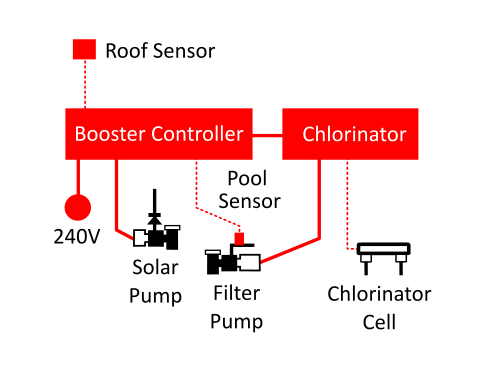
- Solar ports present: If the pool has dedicated solar suction/return, independent/integrated is usually simplest and most efficient.
- Roof height & pipe run: Two-storey roofs or greater and/or long runs favour a booster or a larger independent solar pump.
- Filter schedule vs sun hours: If you don't want to run the filter whenever the sun's out, avoid auto-valve/booster and use an independent system.
- Surge start-up current: Variable-speed filter pumps should use a booster system (soft-start) or with independent systems (no dependency).
- Electrical efficiency: Independent (small pump) < Auto-valve (filter pump) < Booster (two pumps).
- Budget & parts count: Independent system has the fewest components; auto-valve adds actuator; booster adds a pump.
Recently we developed a new angled warming plate to mount
thermostats on as we noticed that modern high-flow collectors use
smaller pumps which allow for longer run times and better turnover
of pool water. Longer pump running removes warm water surface
stratification; lowering heat losses overnight. Hence a warming
plate is of benefit in helping the controller to run the system for
longer. A warming plate also has the following benefits:
• Provides more accurate internal collector
temperature readings than a lone roof-adhered sensor and allows for
off-roof mounting for installations involving excessive cable run
length.
• Reduces the number of ON/OFF
fatigue working cycles the collector experiences as well as the peak fatigue stress polymers
experience – extending the collectors' lifespan.
• Better samples scattered ambient cloud
energy, allowing longer run times during marginal collecting times;
maximizing turnover and pool temperature, due to the mixing of the
stratification layer.

Q. What does a solar pool heating
controller actually do?
A. It compares roof temperature
(as a proxy for the maximum possible collector temperature) with pool
water temperature and circulates water to the collectors when there is
heating to be gained, so you capture heat without babysitting the
system.
Q. Do I need a controller if I have
a manual valve?
A. You can run a solar system
manually or on a timer, but you may miss out on good sun hours and/or
you may risk cooling your pool's water if your system runs during
intermittently cloudy, cold-air times. Typically, we size solar
collector systems up by at least 20% to account for this; an extra 20%
collector could account for the cost of a solar controller, so it's
generally not worth it; however, there are times when it may be; for
example, the auto-valve controllers, given the number of components and
sophistication, are typically quite expensive. If you are running PVC
strip it's worth just putting the system on a timer, as 20–30% extra
strip is of lower cost than the controller.
Q. What's the difference between
independent and booster-pump systems?
A. Independent controllers power
a separate solar pump/valve without talking to pool automation; ideal
for when filtration times don't match sun hours as the systems run
independent. Booster systems use a dedicated pump for solar that is
locked to run with the main filter pump, better suited for second-storey
or higher roofs/long runs.
Q. Will an independent controller
and system heat when my filtration pump is off?
A. Yes, an independent system
uses separate suction lines and can run independent from your main
filter pump.
Q. Can a controller cool an
overheated pool?
A. Yes, some specific solar
controllers have a “tropical mode" that will circulate pool water
through your collectors at night that can cool your pool if it reaches
temperatures that are too warm to be comfortable.
Q. Where should sensors go?
A. Pool sensor: is typically
mounted by inserting into a drilled hole in the solar pump's suction
line. Roof sensor: is mounted on our angled warming plate and the plate
is installed at specific angles.
Q. Do I need a booster pump?
A. This depends on whether you
have — or can retrofit — dedicated solar suction lines. In this case you
can install a larger solar pump to pump up to whatever height you need.
If you don't have — or can't install — such lines, then there are two
systems available to you, an auto-valve system and a booster pump
system. If the install height is more than, say, 3 m we recommend a
booster system be installed. This is because a filter pump is mainly
geared for flow but not pump height; that means it might have issues
powering the filter and a two-storey solar install.
Q. What's the ideal collector flow
rate?
A. For typical unglazed solar
mats: about 2–7 L/min per m² of collector area is recommended. Some
panels can take more; too low a flow will keep collectors too warm up on
the roof and not strip heat fast enough. Conversely, too high a flow may
over-pressurize collectors. Note, higher flow rates will help heat your
pool, as turning over the pool water aids in removing the stratification
layer that is developed during the day, mixing pool water deeply and
reducing losses overnight.
Q. Can I plug both the filter pump
and solar pump into the same controller outlet?
A. No. The controller's outlet
is for the solar pump only. Sharing loads can overload the controller
and void warranties.
Q. Are these controllers
weatherproof?
A. They should be treated as
somewhat weather-resistant, but not weatherproof. It's recommended for
maximum longevity to mount them in a sheltered location, off the ground,
and within electrical clearances from the water.
Q. Why does the roof temperature
look “too high”?
A. The roof sensor is installed
on the roof, not on a collector. It reads a temperature that is supposed
to represent the maximum instantaneous stagnation temperature of the
collector (this is an important point on a collector's efficiency
curve). This information is used to determine if the pump is worth
running for the heat gained.
Q. My controller shows a sensor
fault—what now?
A. Many units flag thermostat
faults. You can switch the plugs between the pool sensor and roof sensor
to see if the fault indicator switches from one to the other thermostat;
if so, you'll need a new thermostat.
Q. Can a controller work with a
variable-speed pump (VSP)?
A. Yes. Independent type systems
will run independent of the function of the filter pump. A booster
system controller is recommended for a variable-speed pump, as the
controller will wait until the current surge settles before turning on
the booster pump so as not to over-pressurize the collectors. An
auto-valve system is probably incompatible with a variable-speed pump.
This is because poly solar collectors require a constant (low pressure)
flow through them that is set during installation, while a variable
speed pump will have varying pressures. Some pressures may be
insufficient and create constant bubbling in the pool, and some
pressures may be too high for the collectors.
Q. How do I choose between models?
A. You may need to window your
solar operation or you may need adjustable temperature differentials, or
tropical mode or anti-freeze/boil. You should pick a controller with
suitable functions required. In the past you may have needed to check
the wire run for your roof sensor; however, with our warming plate you
can mount the thermostat almost anywhere as long as it faces the same
compass direction as the solar collectors. Even on a fence.


